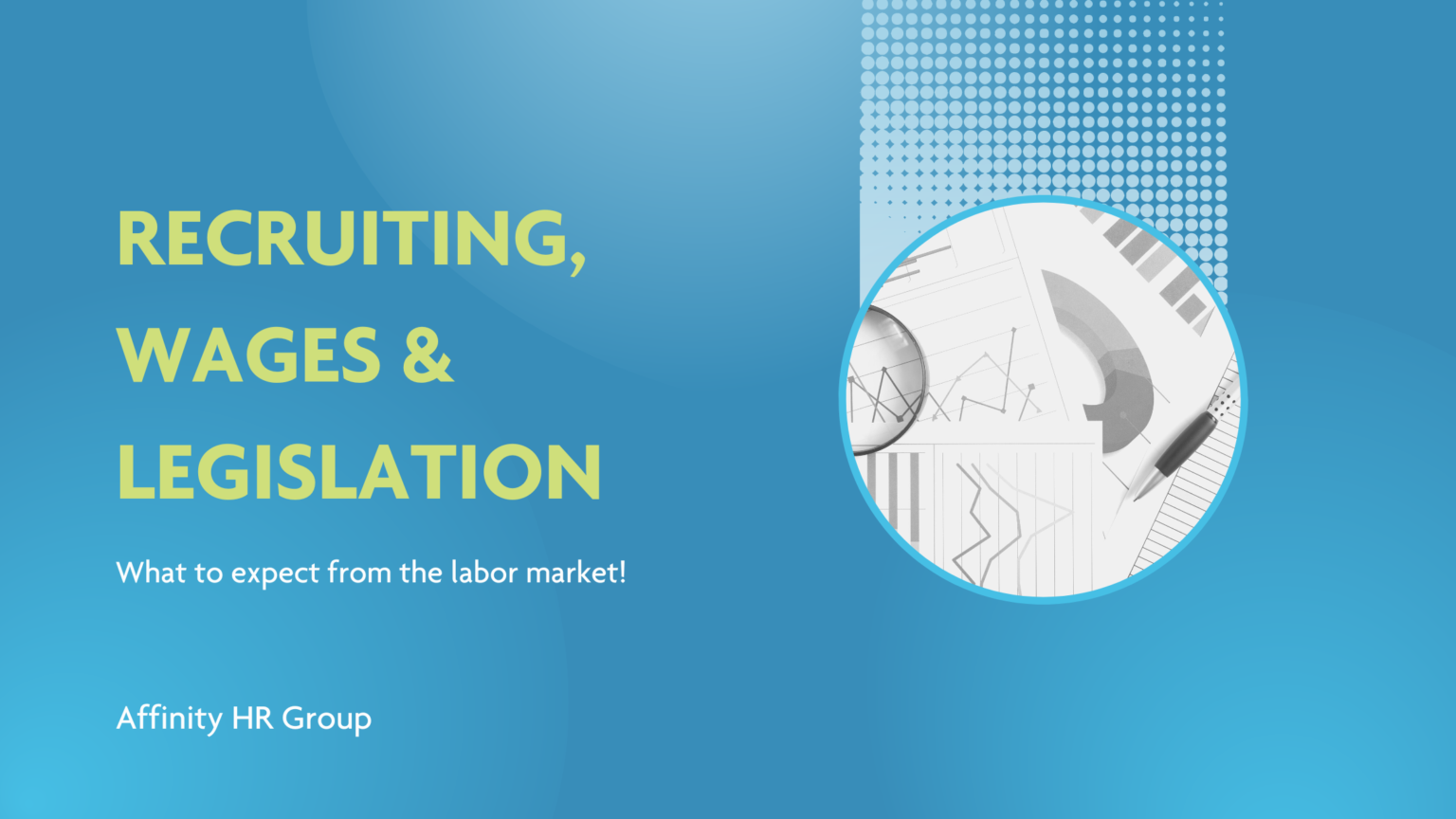The following labor market summary was prepared by Susan Pale, Vice President of Compensation.
Where has 2023 gone? It’s a question I keep asking myself, and I’m guessing many of you are asking the same thing. It seems we were just ushering in a new year. But a lot has happened – inflation rates are going down, fuel prices are $1.00 less than this time last year in many places, and grocery prices dipped in March for the first time since 2020. That’s all good news, right? At the same time, tech, media, finance, and, most recently, retail organizations have announced layoffs of thousands of workers. That’s bad news, right? And the economy has added an average of 341,000 jobs every month during the last 12-month period. We’ll talk more about all this later in this report, but the 2023 labor market has economists, business leaders, and a lot of others scratching their heads.
AI burst into our lives in 2023, and now we can’t help but hear about it every day. There’s way too much information to even begin to incorporate here, but my Affinity HR Group friend and colleague, Paige McAllister, has written a great, informative article titled The AI Revolution: Impacts on Workplaces and HR. Be sure to check it out at https://affinityhrgroup.com/the-ai-revolution-impacts-on-workplaces-hr/. The only other thing I am going to say about AI is that the content of this report was not created with the assistance of generative AI.
Recruitment and Unemployment
On July 6, the United States Department of Labor (USDOL) issued its Job Openings and Labor Turnover Survey (JOLTS report) for May 2023. There is a ton of information in this report, but some of the information below may help to explain why the labor market continues to be strong.
| Category | Number as of 5/31/2023 | Number as of 12/31/2022 | 5 Month Change |
| Job Openings | 9.8 million | 10.8 million | -1,000,000 |
| Hires | 6.2 million | 6.4 million | -200,000 |
| Separations | 5.9 million | 5.9 million | Unchanged |
During this 5-month period, the largest decreases in job openings occurred in the healthcare, finance and insurance, and other services sectors.
The US also added 209,000 new jobs in June 2023. While this is a more modest number than in the past few months, it remains significantly high, as does the unemployment rate, which remains quite low at 3.6%.
As always, unemployment varies significantly by geographic area. Right now, the areas with the lowest unemployment rate (under 1.5%) are all located in Vermont and New Hampshire. And, not so unusually, El Centro, California tops the list with a 16.0% unemployment rate.
We’ve all been hearing about layoffs in the last several months. Some of the numbers are big, but it’s important to understand the context. A lot of organizations really ramped up hiring during COVID and post-COVID and are now shedding some of those hires. For example, Microsoft announced it would lay off 10,000 employees earlier this year. That sounds like a huge number, but Microsoft hired almost 60,000 employees during the last three years. So they still end up with 50,000 more employees than three years ago.
HR Brew reported back in May that several states, in an attempt to address labor shortages, have passed legislation to allow minors to work later and longer hours. In Ohio, the 7 p.m. work limit will be eliminated for children aged 14 and 15 during the school year, and in Iowa children aged 16 and 17 will be allowed to serve alcohol with a parent’s permission. All this comes at the same time as the USDOL is reporting that child labor law violations have increased 69% since 2018.
What employers need to do
- Don’t assume that a decreased number of job openings and possible layoffs mean that recruitment will be easier in 2023. This remains a volatile labor market
- If you recruit for entry-level positions, anticipate continued high demand for candidates
- Identify the best resources to help you stay informed about labor market activity in the market(s) where you operate and consult those resources regularly
- Regularly review and update your application process. Consider mobile-optimized applications, submissions via LinkedIn and other social networks, and one-click job applications if you don’t already have them
- Be respectful of your applicants and their investment in the application and interview process
Wage Growth
The USDOL reports that wages for all positions increased by +4.3% during the 12-month period ending in May 2023. This increase was slightly lower than projected. This slowdown in wage growth, coupled with a continued strong labor market, most likely has contributed to lower inflation rates and lowered the risk of a recession later in 2023.
In April, the Economic Research Institute updated its salary increase projections for 2023 to 3.79% and salary structure increases to 2.91%. These projections are slightly higher than the 3.5% salary increase and 2.7% salary structure projections made back in January. Similarly, the Conference Board projects salary increases of 4.3% across industries for 2023, and the Society for Human Resource Management projects salary increases of 4.6%.
It’s early in the year for 2024 wage growth projections – the large compensation consulting firms generally release their next-year compensation forecasts in the fall. But it is likely that wage growth will be significant in high-demand occupations such as healthcare practitioners and healthcare support personnel.
The staffing firm Robert Half reports that employees who changed jobs in 2022 experienced higher wage growth than those who remained in their positions. That suggests that there is still a very competitive recruiting market for some positions and that many organizations, often smaller businesses, continue to struggle to recruit top talent.
What employers need to do
- Wage growth will continue to vary significantly by occupation type and geography. Remain aware of the differences in all the markets where you operate
- Develop and implement a long-term salary planning process that addresses current and anticipated labor market issues
- Conduct (at minimum) an annual review of current pay policies for competitiveness in recruiting market(s) and anticipate the need to increase wages to recruit and retain
- If raising pay is necessary to hire new talent, review pay levels for current, experienced employees to ensure internal equity and minimize salary compression
Minimum Wage
It’s mid-year, so there aren’t as many changes to minimum wage as typically occur on January 1, but there is quite a bit of activity.
- 18 municipalities (12 in CA, 2 in IL, 1 in MD, 2 in MN, 1 in WA) had changes scheduled for 7/1/2023
- Minimum wage in FL will increase to $12.00 on 9/1/2023
- Minimum wage in NV increased to $11.25 on 7/1/2023. Organizations offering health insurance to employees are allowed to pay $1.00 less than the specified minimum
Currently 19 states index minimum wage changes to cost of living increases. Expect more states to adopt these types of indexed changes in the absence of any federal minimum wage legislation.
Employees working remotely are generally subject to minimum wage statutes in the state or municipality where they work. Traveling remote employees (e. g. living and working in an RV) and those who move from one location to another present an additional challenge. There isn’t a lot of legislation governing these situations, but don’t hesitate to reach out to us at Affinity HR Group should you need assistance with this subject.
What Employers need to do
- Be aware that minimum wage changes may not be state-wide and may not take effect on January 1
- Understand the differences between specified minimum wages and prevailing wages. The USDOL reports that ND and SC were among the states with the highest wage growth in 2022. Both states have a current minimum wage of $7.25
- Keep informed of what’s happening at federal, state and local levels in all the locations where they do business. The Economic Policy Institute’s Minimum Wage Tracker contains a comprehensive list of current and projected minimum wage rates. Check it out at https://www.epi.org/minimum-wage-tracker/
Legislative Outlook
Earlier this year Marty Walsh left his position as Secretary of Labor to become Executive Director for the NHL Players Association. I’ve only included this information because it is evidence that career paths sometimes take pretty interesting turns. His successor, Julie Su, is likely to continue to address priorities recommended by the Government Accountability Office (GAO). These include taking steps to address increasing workplace violence against healthcare workers, enhancing unemployment insurance, and reviewing and assessing response to the COVID-19 pandemic.
In February, the National Labor Relations Board (NLRB) ruled that employers may not offer severance agreements that require employees to waive their labor law rights. The decision means that employers who offer severance agreements to furloughed employees can’t include prohibitions against making statements against the employer or disclosing the terms of the agreement as part of the agreement itself. The Board determined that requiring employees to give up their rights to benefits violates the National Labor Relations Act.
In January, the Federal Trade Commission (FTC) issued a proposed ruling to ban the use of noncompete clauses. The agency says that such a ban would be beneficial to both employees, who are now prevented from seeking other job opportunities, and employers, who can’t recruit and hire employees bound by noncompete clauses. A final ruling is expected in 2024. Organizations will have 180 days to comply with the final ruling.
Paid family leave is not likely to be a federal legislative priority for the remainder of President Biden’s term. The debt ceiling deal reached in early June does not provide funding for the creation/expansion of any paid leave programs.
There hasn’t been much activity at the state level on this issue either. Eleven states and the District of Columbia now offer some type of paid family leave for employees; no states have added paid family leave legislation so far in 2023. The USDOL reports that only 24% of all US workers have access to paid leave, and only 6% of the lowest 10% of all earners receive any type of PTO.
What employers need to do
- Consider subscribing to Affinity HR Group’s HR Support Plan which tracks federal and state legislative updates that affect workplace policies and practices (http://www.affinityhrgroup.com/hrsupportplan)
- Legislation often happens more quickly at the state and municipal levels than at the federal level. Identify the resources necessary to stay informed of changes and new requirements and consult them regularly
- Recognize that offering paid family leave may offer a competitive advantage in hiring and retention
Compensation and Benefit Issues and Trends
As always, it’s difficult to pick a few “hot topics” when there are so many right now. So here are some of the 2023 mid-year items to keep you awake at night.
#1-The Labor Market Conundrum, A Tale of Two Labor Markets, or WHAT??
I reviewed several articles by economists and business leaders before writing this in an attempt to get some clarity around current labor market issues. The result: I’m more confused than ever but not feeling so bad because everyone else seems pretty confused too.
This economic roller coaster is best illustrated by egg prices. Egg prices increased over 70% during 2022. Prices here in Arizona were $5.00+ a dozen in December if you could find them. The last ones I bought were $1.39. USA Today reports that wholesale egg prices are down more than 80% since December, with no single, simple explanation of why.
There’s quite a bit of good news out there for employers:
- The debt ceiling deal reached in early June removed a lot of economic uncertainty for markets and decisions-makers – at least in the short-term
- The debt ceiling deal is expected to have minimal impact on the overall economy. Goldman Sachs and JP Morgan estimate only a decrease of .1% -.2% in GDP over the next year
- The June Federal Reserve decision to not raise interest rates – at least for now – will make borrowing money a bit more affordable for both businesses and consumers
- The US unemployment rate remains at historic lows. As of June, the number is 3.6%
- The economy continues to add jobs at a brisk pace – 339,000 new jobs were added in May, 209,000 in June
- Despite headlines describing massive layoffs, many of these job cuts are open positions, reductions through attrition, and the need to recalibrate after “bulking up” hiring during the last 3 years
But there are also some areas of potential concern:
- Despite the Federal Reserve decision to hold interest rates at current levels, rates remain high. These high interest rates may be a deterrent to businesses desiring to expand and hire
- The Federal Reserve has left the door open to additional interest rate hikes later in the year
- The US inflation rate was 3.0% in June, down from last year’s high of 9.1%. That’s still a high number, and disproportionately impacts low-income workers
- Student loan payments, deferred since the COVID-19 pandemic, are scheduled to resume in September. These payments are often substantial, and incomes in many households will be negatively impacted
Issue #2 – Pay Transparency and Pay Equity
I’ve written about both pay transparency and pay equity in the past, but increasingly we’re seeing the two terms used interchangeably. They aren’t really the same.
Pay transparency is defined by World at Work as “the degree to which employers are open about what, why, how, and how much employees are compensated.” Pay transparency is often driven by legal requirements. These may include requirements that employers list salary ranges for open positions (4 states plus New York City), prohibit employers from asking salary history in interviews (currently 26 states), and provide protection for employees that discuss pay (all employees covered by the National Labor Relations Act are protected).
Compliance with legal requirements often means that current employees find out about pay ranges for their positions from job postings or external applicants. Employers that are proactive about communicating compensation information to all employees will have a competitive advantage not only in attracting new employees, but increasing employee engagement and satisfaction as well.
Pay equity is achieved by identifying pay gaps within an organization and taking steps to minimize/eliminate them. This is most often accomplished by conducting internal pay audits and adjusting salaries to address gaps and inequities
There is considerable pay equity legislation, much of which is designed to address gender pay gaps. The federal Equal Pay Act sets a minimum standard for pay equity, but most states have either passed, or are considering, some type of pay equity legislation. State laws vary significantly, so it’s important to be aware of the legislation that applies to you and your employees.
To summarize, an increase in pay transparency, whether legally required or not, can result in an increase in pay equity.
#3-Impact of Dobbs v. Jackson on Employers and the Workforce
The first anniversary of the Supreme Court decision that overturned Roe v. Wade has just passed. And the number of questions and issues raised by the decision continues to grow.
The decision returned the power to regulate abortion to individual states. Abortion is now illegal in almost all circumstances in 15 states. That’s up from a total of 7 states at the beginning of the year. An additional 6 states have proposed bans that are currently temporarily blocked by court rulings.
Nineteen states and the District of Columbia have passed legislation designed to protect abortion access. These laws are designed not only to protect residents of the state and doctors who practice in the state, but also provide some legal cover to women who cross state lines to terminate pregnancies.
Earlier in the year, 88 prosecutors – mostly district attorneys and state attorney generals – signed a statement vowing not to prosecute abortion-related crimes. These prosecutors represent approximately 91.5 million people in 30 states. In response, lawmakers in Texas and Georgia have introduced bills that would ban district attorneys from having a policy of not enforcing prosecution of a particular offense.
We are starting to see other impacts as well. Medical residents typically get their residency assignments in May. There are declines in the numbers of students seeking residencies in OB/GYN specialties. And some residents are altering their plans of where to complete their training and where they will ultimately practice.
What employers need to do
- Understand the complexities of the current labor market (it’s not easy) and recognize that recruiting and retaining top talent will continue to present challenges
- Educate leaders, managers, and supervisors about compensation policies and procedures and hold them accountable for appropriate communication with employees
- Conduct (at minimum) an annual review of current pay levels to ensure compliance with applicable laws regarding pay transparency and pay equity
- Consider what short- and long-term actions you may need to take to attract and retain women in your workforce
COVID-19
May 11 marked the end of the COVID-19 Public Health Emergency, which had been in place for more than three years. However, saying the emergency is over is proving to be quite different from all things COVID actually being over.
The CDC reports that about 40,000 people have died of COVID-19 so far this year, and COVID was the fourth leading cause of death in the US in 2022.
The end of the Public Health Emergency has ramifications for many of us:
- Vaccines will continue to be available at no charge while supplies last
- At home tests may not be covered by insurance
- Medications to treat COVID, such as Paxlovid, will continue to be free while supplies last
- Hospitals will no longer receive extra payments for care of COVID patients
More significantly, enhanced benefits authorized through the Supplemental Nutrition Assistance Program (SNAP) and funded by the federal government are now being rolled back by individual states. A recent New Yorker article reports that the average SNAP recipient is expected to lose about one third of their monthly allotment. Approximately 40 million Americans receive SNAP benefits.
During the pandemic, individual states received additional federal funding to expand their Medicaid programs. As a result of this expansion, the uninsured rate in the US fell to 8%. But states are now able to start purging their Medicaid rolls (that was prohibited during the Public Health Emergency), and the CDC estimates that up to 15 million people could lose their health coverage in 2023. Medicaid and the Children’s Health Insurance Program (CHIP) now cover about 93 million people.
What employers need to do
- Contact Affinity HR Group for the latest information about COVID (Hello@AffinityHRGroup.com)
- Discuss any changes to insurance coverage with your carrier and communicate these changes to your employees
- Understand the impact that changes to SNAP and Medicaid programs may have on employees and their families. These impacts will vary considerably by location – it is estimated that 1 million people in FL alone may lose their Medicaid coverage
Labor Market and Occupational Outlook – All Positions
As noted above, wage growth has slowed over the past several months. Despite that slowdown, wage increases continue to be in the 4% – 5% range for most positions. The job sectors shown in the table below all reported significant wage gains from June 2022 through June 2023.
| Job Sector | June 2022
Hourly Salary |
June 2023
Hourly Salary |
% Increase |
| All Nonfarm Positions | $32.06 | $33.44 | +4.3% |
| Leisure/Hospitality | $19.98 | $21.07 | +5.5% |
| Professional/Business Services | $38.62 | $40.25 | +4.2% |
| Construction | $34.53 | $36.29 | +5.1% |
| All Manufacturing | $30.86 | $32.11 | +4.1% |
Despite this slowing of wage growth, several job markets in the US remain what Leaders.com describes as “hot.” Interestingly, they are all in the sunbelt. These metro areas have been flooded with young, educated workers looking for more affordable housing and good education systems. But the large numbers of corporate relocations, expansions and start-ups have resulted in fierce competition for workers. If you’re located in one of these areas, expect challenges in recruiting new employees and keeping the ones you have.
“Hot” Job Markets
| Rank | Metro Area |
| #1 | Nashville TN |
| #2 | Austin TX |
| #3 | Jacksonville, FL |
| #4 | Dallas, TX |
| #5 | Raleigh, NC |
What employers need to do
- Be aware of differing wages and wage growth in different labor markets. This is critical for employers doing business in multiple locations
- Identify the best resources to help you understand and respond to market changes in the geographic area(s) where you operate and consult those resources regularly to stay informed
Affinity HR Group can help you tackle your biggest compensation challenges. Connect with us at 877-660-6400 or hello@AffinityHRGroup.com to learn more or to request a pdf version of our latest Labor Market Summary!






